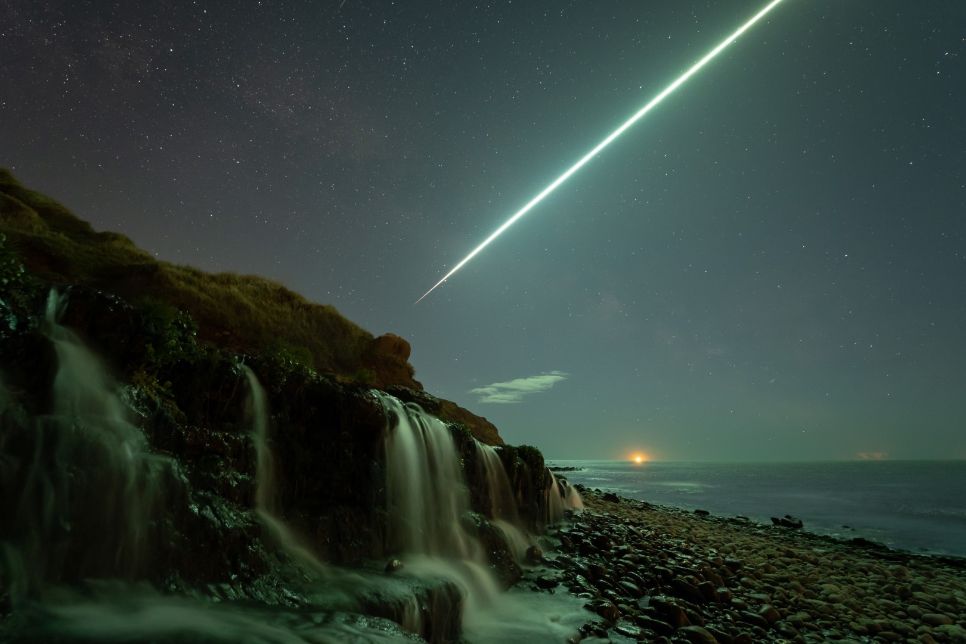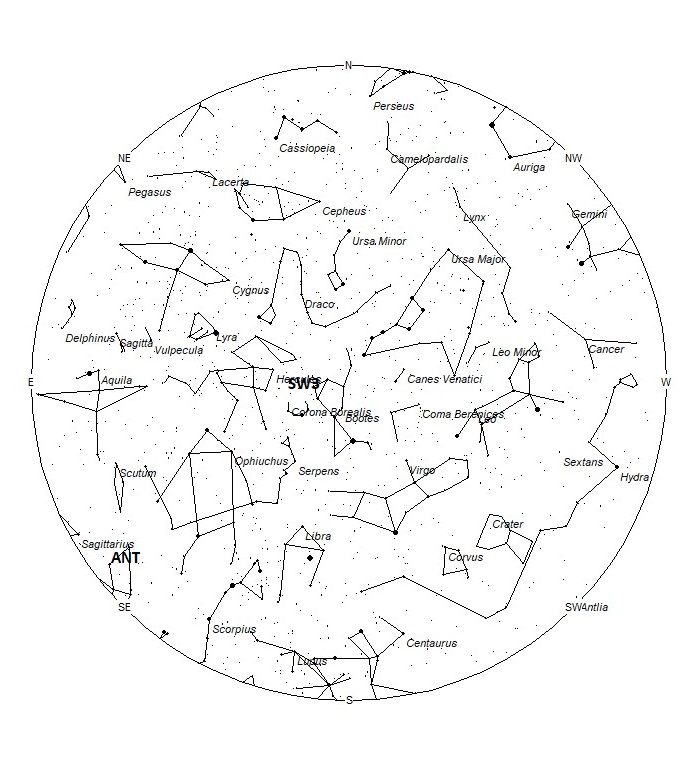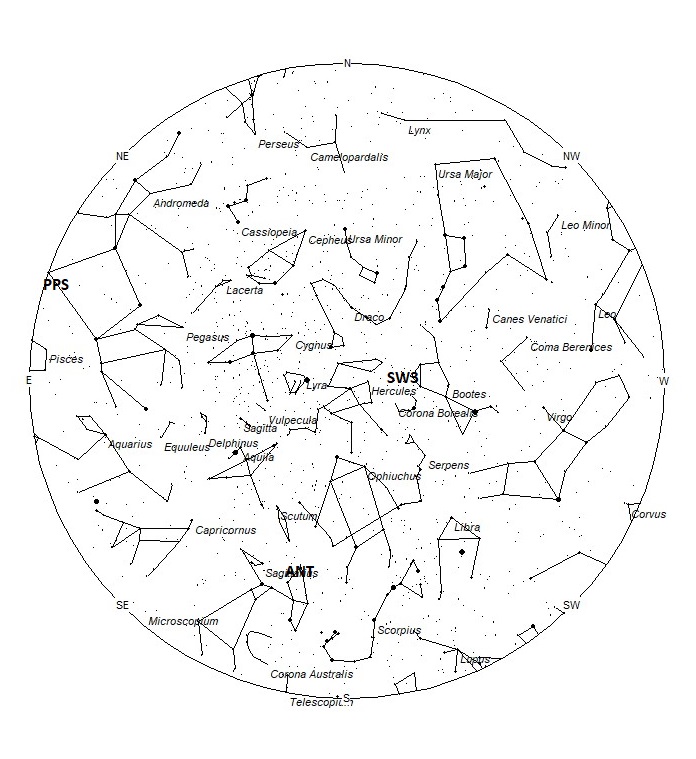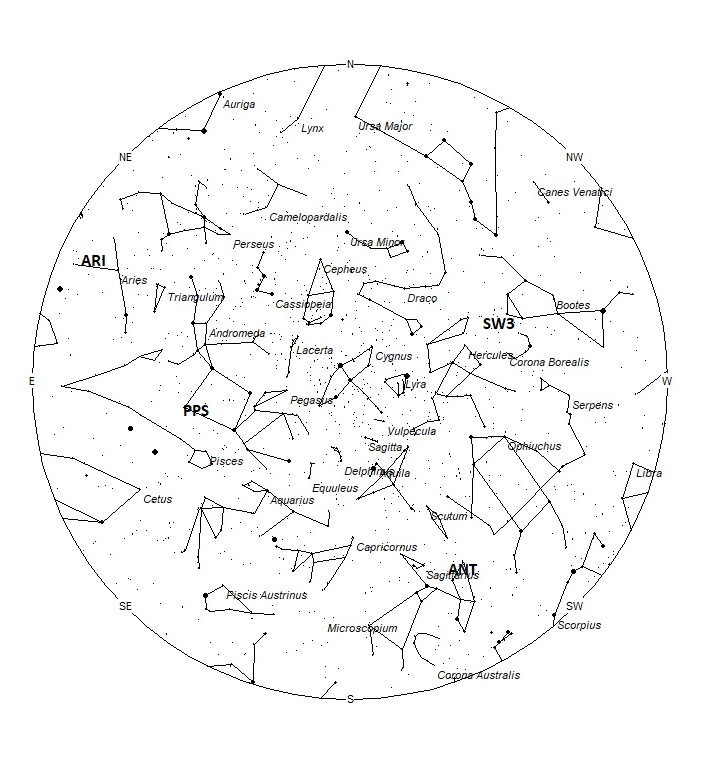
During this period, the moon reaches its full phase on Tuesday June 14th. At that time the moon is located opposite the sun and will remain in the sky al night long. This is the worse time of the month to try and view meteor activity as the bright moonlight will obscure all but the brighter meteors. The estimated total hourly rates for evening observers this week should be near 1 as seen from mid-northern latitudes (45N) and 2 as seen from tropical southern locations (25S) For morning observers, the estimated total hourly rates should be near 4 as seen from mid-northern latitudes (45N) and 6 as seen from tropical southern locations (25S). Rates are reduced due to moonlight. The actual rates will also depend on factors such as personal light and motion perception, local weather conditions, alertness, and experience in watching meteor activity. Note that the hourly rates listed below are estimates as viewed from dark sky sites away from urban light sources. Observers viewing from urban areas will see less activity as only the brighter meteors will be visible from such locations.
The radiant (the area of the sky where meteors appear to shoot from) positions and rates listed below are exact for Saturday night/Sunday morning June 11/12. These positions do not change greatly day to day so the listed coordinates may be used during this entire period. Most star atlases (available at science stores and planetariums) will provide maps with grid lines of the celestial coordinates so that you may find out exactly where these positions are located in the sky. I have also included charts of the sky that display the radiant positions for evening, midnight, and morning. The center of each chart is the sky directly overhead at the appropriate hour. These charts are oriented for facing south but can be used for any direction by rotating the charts to the desired direction. A planisphere or computer planetarium program is also useful in showing the sky at any time of night on any date of the year. Activity from each radiant is best seen when it is positioned highest in the sky, either due north or south along the meridian, depending on your latitude. It must be remembered that meteor activity is rarely seen at the radiant position. Rather they shoot outwards from the radiant, so it is best to center your field of view so that the radiant lies at the edge and not the center. Viewing there will allow you to easily trace the path of each meteor back to the radiant (if it is a shower member) or in another direction if it is sporadic. Meteor activity is not seen from radiants that are located far below the horizon. The positions below are listed in a west to east manner in order of right ascension (celestial longitude). The positions listed first are located further west therefore are accessible earlier in the night while those listed further down the list rise later in the night.
These sources of meteoric activity are expected to be active this week.
Details of each source will continue next week when viewing conditions will be more favorable.
You can keep track of the activity of these meteor showers as well as those beyond the limits of visual observing by visiting the NASA Meteor Shower Portal available at: https://meteorshowers.seti.org/ You can move the sky globe to see different areas of the sky. Colored dots indicate shower meteors while white dots indicate sporadic (random) activity. The large orange disk indicates the position of the sun so little activity will be seen in that area of the sky.
The list below offers the information from above in tabular form. Rates and positions are exact for Saturday night/Sunday morning except where noted in the shower descriptions.
| SHOWER | DATE OF MAXIMUM ACTIVITY | CELESTIAL POSITION | ENTRY VELOCITY | CULMINATION | HOURLY RATE | CLASS |
| RA (RA in Deg.) DEC | Km/Sec | Local Daylight Saving Time | North-South | |||
| Schwassmann-Wachmann 3 (SW3) | Jun 02 | 15:41 (235) +37 | 15 | 23:00 | <1 – <1 | III |
| Anthelions (ANT) | – | 18:16 (274) -23 | 30 | 02:00 | <1 – 1 | II |
| phi Piscids (PPS) | Jun 25 | 00:02 (001) +15 | 66 | 08:00 | <1 – <1 | IV |
| Daytime Arietids (ARI) | Jun 04 | 03:07 (047) +25 | 42 | 11:00 | <1 – <1 | IV |
 American Meteor Society
American Meteor Society



Thanks for the feature!
To tell the truth, I really like exploring space and delving into it because you can observe so many unique phenomenons there. You gave such a detailed and full description of all important nuances and amazed me with so many new interesting facts. Of course, meteor activity depends on many factors. it is really important to calculate and take them into account in order to see meteorites. It is so interesting that up to 4 billion meteoroids fall to Earth every day, but people don’t have such an opportunity to see all of them. I think that it is really important to develop your knowledge about meteorites and astronomy in general because it is absolutely unique information which will help write such wonderful articles, blowing people’s minds with incredible facts. Also, this photo indicates that space is so incomprehensible and that it is a true embodiment of everything beautiful which can take our conscience to the next level, expanding our mind.